Hundreds of evacuees from the area around Japan's stricken nuclear power plant are being turned away by hospitals and temporary evacuation centers because of fear they may be carrying radiation, a British newspaper reported.
that evacuees provide certificates proving they have not been exposed to contamination.
The newspaper said a clinic in Fukushima City refused treatment to an 8-year-old girl for a skin rash. Her family was living in a shelter after abandoning their home in Minamisoma, 18 miles from the nuclear plant.
The newspaper noted that the prejudice was similar to the ostracism that survivors of the atomic bombings of Hiroshima and Nagasaki in 1945 experienced.
"This is a knee-jerk reaction based on the fear that these people are going to harm you," Dr. Robert Gale, a hematologist at Imperial College, London, told the Daily Telegraph. He is advising the Japanese government on health issues.
"If someone has been contaminated externally, such as on their shoes or clothes, then precautions can be taken, such as by removing those garments to stop the contamination from getting into a hospital," he added. "That is very easy to do, but unfortunately I'm not surprised this sort of thing is happening."
Meanwhile, Japan's Nuclear and Industrial Safety Agency said Thursday that consistently high levels found in seawater outside the plant may mean radiation is leaking out continuously.
"That is a possibility," Agency Deputy Director-General Hidehiko Nishiyama told a news conference when asked if there was continuous contamination of the sea.
He added that regulators and engineers did not know where the leaks may be.
Radioactive iodine in seawater near the drains running from the plant was 4,385 times more than the legal limit, the highest recorded since the crisis was triggered by an earthquake and tsunami on March 11. On Wednesday, nuclear safety officials said seawater 300 yards outside the plant contained 3,355 times the legal limit.
The U.N. nuclear watchdog has suggested Japan consider widening the evacuation zone around the stricken Fukushima Dai-ichi nuclear plant.
The International Atomic Energy Agency (IAEA) said radiation measured at the village of Iitate, 40 km (25 mile) from the plant, exceeded a criterion for evacuation.
that cesium 137, a long-lasting radioactive element, was measured at the village at a level higher than the standard the Soviet Union used to recommend abandoning the land surrounding Chernobyl.
Japan has ordered those within a 12.5-mile radius from the plant to leave and is encouraging those living in a 12.5 to 19-mile ring to do the same, and if they don't, to stay inside.
"We have advised (Japan) to carefully assess the situation and they have indicated that it is already under assessment," Denis Flory, a deputy director general of the IAEA, said.
In other developments in the nuclear crisis that followed the devastating earthquake and tsunami that hit northeastern Japan:
- French President Nicolas Sarkozy was due to arrive in Japan Thursday, the first leader to visit since the devastating earthquake and tsunami sparked the worst nuclear crisis since Chernobyl in 1986.
- Flory said that Singapore had told the U.N. nuclear watchdog that some cabbages imported from Japan had radiation levels up to nine times the levels recommended for international trade. Across the Pacific,
- TEPCO said it was inevitable that it would have to scrap four of the six reactors at the Fukushima Dai-ichi plant.
Edano's gloomy assessment caused dismay in the area around the plant.
"We must do everything we can to end this situation as soon as possible for the sake of everyone who has been affected," said Yuhei Sato, governor of Fukushima prefecture Wednesday. "I am extremely disappointed and saddened by the suggestion that this might drag out longer."
Slideshow 9 photos
After Japan's earthquake and tsunami - week 8
As officials seek to bring an end to the nuclear crisis, hundreds of thousands in the northeast are still trying to put their lives back together following the earthquake and tsunami, which killed more than 11,000 people and left over 16,000 missing.
The government said damage is expected to cost $310 billion, making it the most costly natural disaster on record.
In the town of Rikuzentakata, one 24-year-old said she's been searching every day for a missing friend but will have to return to her job at a nursing home because she has run out of cash.
Life is far from back to normal, she said.
"Our family posted a sign in our house: Stay positive," Eri Ishikawa said, but admitted this was a struggle.
The country's Emperor Akihito and Empress Michiko reached out to some of the thousands displaced, spending about an hour Wednesday consoling a group of evacuees at a Tokyo center.
"I couldn't talk with them very well because I was nervous, but I felt that they were really concerned about us," said Kenji Ukito, an evacuee from a region near the plant. "I was very grateful."
